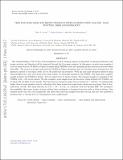Files in this item
Very low-mass stars and brown dwarfs in Upper Scorpius using Gaia DR1 : mass function, disks, and kinematics
Item metadata
| dc.contributor.author | Cook, Neil J. | |
| dc.contributor.author | Scholz, Aleks | |
| dc.contributor.author | Jayawardhana, Ray | |
| dc.date.accessioned | 2017-12-12T15:30:10Z | |
| dc.date.available | 2017-12-12T15:30:10Z | |
| dc.date.issued | 2017-12 | |
| dc.identifier | 251730879 | |
| dc.identifier | 50405083-b4a5-4e37-beb9-6c86489859e2 | |
| dc.identifier | 85039451515 | |
| dc.identifier | 000425442400001 | |
| dc.identifier.citation | Cook , N J , Scholz , A & Jayawardhana , R 2017 , ' Very low-mass stars and brown dwarfs in Upper Scorpius using Gaia DR1 : mass function, disks, and kinematics ' , Astronomical Journal , vol. 154 , no. 6 , 256 . https://doi.org/10.3847/1538-3881/aa9751 | en |
| dc.identifier.issn | 0004-6256 | |
| dc.identifier.other | BibCode: 2017AJ....154..256C | |
| dc.identifier.uri | https://hdl.handle.net/10023/12316 | |
| dc.description.abstract | Our understanding of the brown dwarf population in star-forming regions is dependent on knowing distances and proper motions and therefore will be improved through the Gaia space mission. In this paper, we select new samples of very low-mass objects (VLMOs) in Upper Scorpius using UKIDSS colors and optimized proper motions calculated using Gaia DR1. The scatter in proper motions from VLMOs in Upper Scorpius is now (for the first time) dominated by the kinematic spread of the region itself, not by the positional uncertainties. With age and mass estimates updated using Gaia parallaxes for early-type stars in the same region, we determine masses for all VLMOs. Our final most complete sample includes 453 VLMOs of which ∼125 are expected to be brown dwarfs. The cleanest sample is comprised of 131 VLMOs, with ∼105 brown dwarfs. We also compile a joint sample from the literature that includes 415 VLMOs, out of which 152 are likely brown dwarfs. The disk fraction among low-mass brown dwarfs (M < 0.05 M⊙ ) is substantially higher than in more massive objects, indicating that disks around low-mass brown dwarfs survive longer than in low-mass stars overall. The mass function for 0.01 < M < 0.1 M⊙ is consistent with the Kroupa Initial Mass Function. We investigate the possibility that some “proper motion outliers” have undergone a dynamical ejection early in their evolution. Our analysis shows that the color–magnitude cuts used when selecting samples introduce strong bias into the population statistics due to varying levels of contamination and completeness. | |
| dc.format.extent | 19 | |
| dc.format.extent | 1268053 | |
| dc.language.iso | eng | |
| dc.relation.ispartof | Astronomical Journal | en |
| dc.subject | Brown dwarfs | en |
| dc.subject | Stars: luminosity function | en |
| dc.subject | Mass function | en |
| dc.subject | Open clusters and associations: individual: Upper Sco | en |
| dc.subject | Stars: low-mass | en |
| dc.subject | QB Astronomy | en |
| dc.subject | QC Physics | en |
| dc.subject | DAS | en |
| dc.subject.lcc | QB | en |
| dc.subject.lcc | QC | en |
| dc.title | Very low-mass stars and brown dwarfs in Upper Scorpius using Gaia DR1 : mass function, disks, and kinematics | en |
| dc.type | Journal article | en |
| dc.contributor.sponsor | Science & Technology Facilities Council | en |
| dc.contributor.institution | University of St Andrews. School of Physics and Astronomy | en |
| dc.contributor.institution | University of St Andrews. St Andrews Centre for Exoplanet Science | en |
| dc.identifier.doi | 10.3847/1538-3881/aa9751 | |
| dc.description.status | Peer reviewed | en |
| dc.identifier.url | http://adsabs.harvard.edu/abs/2017AJ....154..256C | en |
| dc.identifier.grantnumber | ST/M001296/1 | en |
This item appears in the following Collection(s)
Items in the St Andrews Research Repository are protected by copyright, with all rights reserved, unless otherwise indicated.

